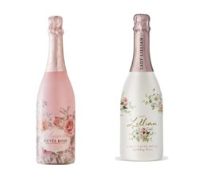- within International Law, Law Department Performance and Consumer Protection topic(s)
- in Africa
We like to report on rulings of the South African Advertising Regulatory Board ("ARB") that are IP-related. Clause 8 of section II of the ARB's Code of Advertising Practice deals with the issue of the exploitation of another party's "advertising goodwill", whereas clause 9 of section II deals with imitation. The trade mark issue of a likelihood of consumer confusion naturally comes up in enquiries of this sort.
On 7 September 2022, the ARB issued a ruling in a case involving possible consumer confusion between two South African sparkling wine brands.
The issue
KWV, the maker of the Annabelle Cuvee Rosé sparkling wine, lodged a complaint about a product of one of its competitors, Du Toitskloof, the maker of Lady Lillian sparkling wine. The complaint was that the get-up of the Lady Lillian sparkling wine, which was launched in May 2022, is so similar to the get-up of KWV's Annabelle Cuvee Rosé sparkling wine, that there is likely to be consumer confusion.
The matter is clearly one of considerable commercial significance. KWV, which launched its Annabelle Cuvee Rosé in 2019 and claims to have spent some ZAR9.5-million on advertising the brand, argues that it has built up considerable goodwill, holding a 22% share of the sparkling rosé market in South Africa.
KWV's case
KWV claimed that the "packaging architecture" of the Lady Lillian product is clearly similar to that of the Annabelle Cuvee Rosé product. The alleged similarities are:
- both bottles are "sleeved" in white;
- both bottles have a similar rosé gold-coloured foil;
- both products have female names; and
- both labels feature flowers prominently.
Du Toitskloof's case
The lawyers acting for Du Toitskloof argued that white-sleeved bottles are common in the trade and that they are used to lure female shoppers - Valdo (Prosecco) is said to have started this trend in 2019. They argued that no one company can claim exclusivity in respect of the colour white in packaging.
The lawyers also claimed that the use of female names is common practice in the industry, pointing out that KWV's Annabelle is itself close to a Klein Constantia wine called Cuveé Anabel Rosé, which is packed in a white box with florals.

Source: arb.org.za
The ARB's ruling
The ARB noted the similarities made the point that various aspects of packaging, which on their own might be considered unprotectable, may be protectable in combination.
It held that it is very likely that the makers of Lady Lillian took a "spade of inspiration" from the Annabelle packaging, and that this may result in a loss of advertising value and diminish KWV's advertising goodwill. They further held that the look-and-feel of the Lady Lillian product takes away from the uniqueness of the Annabelle bottle design. It said this:
"The Directorate thinks it highly likely that the consumer will either buy the Lady Lillian thinking that it is the Annabelle, or thinking that the two wines have emerged from the same stable. This is not the case."
The order
The ARB ordered Du Toitskloof to stop selling the Lady Lillian product in the get-up described above by mid-November 2022.
Some words on price and the likely consumer/target market
The ARB made some comments about price and the likely consumer. Here's one:
"It is also true that the wine connoisseurs or wine enthusiasts are not likely to be confused by the product.however this is a sweet sparkling wine that retails at around R90, with an emphasis on the look and feel. It is likely to appeal to someone who casually drinks wine and is not into the whole 'wine estate' aesthetic and branding. there is a high likelihood that this target market are likely to be confused into thinking that the products are related in some way, or similar."
And here's another:
"The target market for sweet sparkling wine at the R90 price point does not enjoy the same levels of brand literacy as, perhaps, the market for imported champagnes. This market is buying based on the 'pretty' aesthetic, and is likely to regard these bottles as being very similar."
It is a well-established rule that the likely consumer is a factor that can and should be considered when determining the likelihood of confusion between two brands. It's also obvious that some buyers will be more knowledgeable and discerning than others. But the use of phrases like "brand literacy" and a "pretty aesthetic" may raise some eyebrows!
The ARB
This ruling is a another reminder of how the ARB can sometimes be used for resolving what are essentially trade mark disputes.
Reviewed by Gaelyn Scott, Head of ENSafrica's IP department.
Read more:
The content of this article is intended to provide a general guide to the subject matter. Specialist advice should be sought about your specific circumstances.


